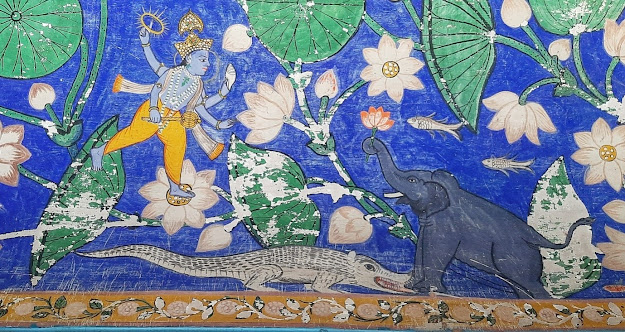THE STORY OF GAJENDRA MOKSHA
दृष्ट्वा गरुत्मति हरि ख उपात्तचक्रम।
न्नारायण्खिलगुरो भगवान नम्स्ते॥३२॥
The
story of Gajendra Moksha or the liberation of Gajendra is a puranic legend from
the eighth skandha of Bhagwata Purana, one of the most sacred
books in Hinduism. The episode of Gajendra Moksha holds a significant place in
Vaishnavism and has great symbolic value for Vishnu devotees. The theme
based on mythological stories of Vishnu is mostly found in the temples of
Vaishnava communities.
The
story is depicted very vividly on the walls of Shree Raghunath Temple in
Bhindar tehsil of Udaipur, Rajasthan. The story is depicted in bright colours on the ceiling of the temple, with a predominant use of blue in the background
representing the water. Delicate outlines with simplistic depiction of the
forms portray a sense of aesthetic taste and artistic sensitivity of the
painter.
The
painting depicts Lord Vishnu in pitambara
(yellow clothes) holding the shankha
and chakra descending on earth to
protect Gajendra, the elephant from the clutches of Makara, the crocodile.
According to the legend, Gajendra, king of elephants, takes great pride in his
strength. He was a devotee of Lord Vishnu and is shown standing in a lake with
a lotus flower in his trunk, an offering to Lord Vishnu. Lotus flowers, leaves
and floating fish complete the imagery of the lake. Also depicted is the crocodile
in the lake that has caught Gajendra by his leg.
In
the Bhagwata Purana, the story was
narrated by Shukla to King Parikshit at the latter’s request. The crocodile
starts dragging the elephant into the water. A helpless Gajendra struggles very
hard to escape from the clutches of the crocodile. After a long struggle,
Gajendra becomes weak and desperate and starts losing hope. Gajendra then calls
for Lord Vishnu to save him. He starts praying, “Narayana, preceptor of all, please
protect me, for I seek shelter at your feet. O Supreme Lord, I have no desire
to live after being released from this crocodile, for I desire only to be
liberated from ignorance.” Hearing his devotee’s cries and prayers, Lord Vishnu
descends and frees Gajendra from the grip of the crocodile by beheading the
crocodile with his Sudarshana Chakra.
According to another legend, Gajendra in his previous life was king Indradyumna, a great devotee of Lord Vishnu. One day, when Indradyumna was in deep meditation, Rishi Agastya came to visit the king. But the king did not notice the arrival of the saint and so, he did not rise up from his seat to greet him. Taking this as an insult, Rishi Agatsya grew angry and cursed him to become an elephant in his next birth. On the other hand, the crocodile in his last life was a Gandharva called Huhu who was also cursed by a sage. As Lord Vishnu flung his Sudarshana Chakra on the crocodile in order to save the life of the elephant, he liberated both of them from the cycle of birth and death.
The prayer made by Gajendra on this occasion became a famous hymn in praise of Vishnu known as the Gajendra Stuti. This hymn was later inducted as the first and foremost hymn of the Vishnu Sahasranama comprising a thousand names of Vishnu.
शुक्लांबरधरं विष्णुं शशि वर्णं चतुर्भुजं ।
प्रसन्न वदनं ध्यायेत् सर्व विघ्नोपशान्तये॥
1. श्रीमदभागवत महापुराण - प्रथम खण्ड, गीता प्रेस गोरखपुर |
2.
भागवत -नवनीत, संतश्रीरामचंद्र
केशवडोंगरेजीमहाराज,
गीता प्रेस गोरखपुर |








Intresting.. well described 👍👍
ReplyDelete